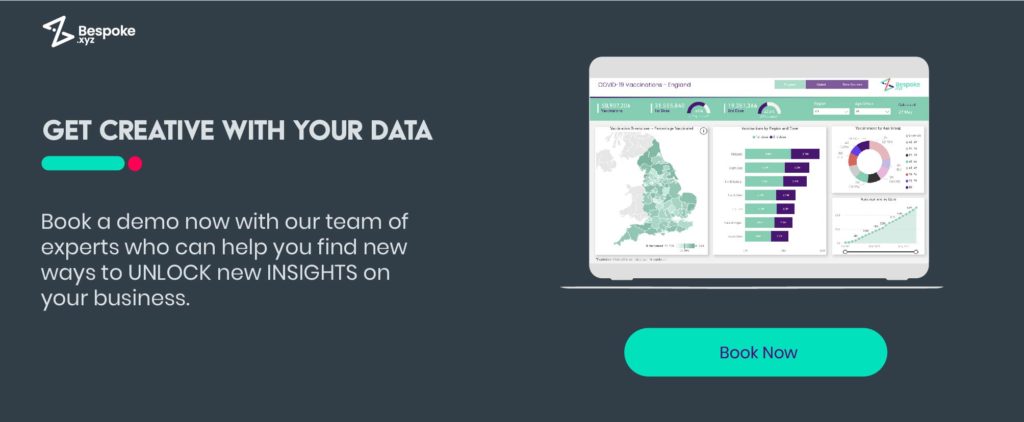Business Intelligence is a suite of software and analysis tools that transforms raw data into tremendous information and insights for any business. But for it to work effectively, it requires a culture of data-empowerment where data ownership is centralised and everybody is able to make use of the insights BI has to offer.
Traditionally, many organisations have placed data ownership into the hands of a single person or team, which can be a huge risk for data security and may even have wide-spread consequences for the business as a whole. For example, if the single BI keyholder happens to leave the business, certain data may not be able to be amended or added to, or worse, may not be able to be accessed at all. At worst this could lead to a huge security breach, but even if not, it majorly slows down processes and employee productivity.
Let’s take a deeper look at why creating a data-empowered workforce is so essential in getting the most from your business intelligence.
Business intelligence is for everybody
First of all, it’s important to remember that BI can and may be utilised by several teams and individuals throughout the business.
This means making sure that BI is accessible not just for different departments, but also customised for the different levels of users across the organisation.
How different departments might use BI
- Finance: reporting, expense management, forecasting, budgeting, and managing revenue, risk and compliance
- Sales: discovering market trends and opportunities, measuring performance and forecasting pipeline
- IT: optimising data governance, security and scalability; spotting underused systems and applications
- Human resources: analysing labour, benefit and recruitment data across the organisation
- Supply chain: forecasting and planning, looking at sourcing and supplier performance; monitoring transportation
- Marketing: better customer segmentation and targeting; campaign analysis; predicting the performance of new business initiatives
The 4 users of business intelligence
The below are four typical examples of business intelligence users. Bear in mind that this list is in no way exhaustive, as users of BI can come in all types and forms.
1. Data Analyst
The data analyst is typically the one who drills deep down into the data. A robust BI platform enables them to do just this, so they can gather new insights and expand on business techniques.
2. IT user
The IT user plays a prominent role in maintaining and strengthening the BI platform’s infrastructure. In some organisations, they might also be the main BI keyholder, responsible for assisting other teams with data requests.
3. Owner/CEO
The owner or CEO will use BI to gain a relevant picture of how things are performing across the company, and take necessary steps to increase efficiency and boost revenue.
4. Business User
General business intelligence users will be distributed in various teams across the business. They can fall into one of two categories: the informal business user (who uses dashboards to analyse predetermined sets of data) and the power user (those capable of toiling complex data sets).
Is one person holding the key to your data?
Many major BI systems such as Microsoft’s Power BI are cloud-based, making them not just incredibly versatile and intuitive, but highly secure too.
Non-custom built data management platforms, such as Excel, lack the security of a cloud-based system as they typically place the ownership or governance in the hands of one person or team. This not only makes it tough for other employees to get the data insights they need, but also places the security of your data at risk.
If the username and password of the person responsible for creating the Excel sheets (or those of a person with editing privileges) were stolen, that means the person who now has access to the sheets can do anything with the data – from deleting it to stealing confidential client details.
The importance of a data-literate workforce
According to new research by Harvard Business Review Analytic Services, nearly 90% of organisations say success depends on data-driven decisions made by frontline employees. However, only 7% of organisations are fully equipping their teams with the analytic tools and resources needed to drive decision-making and autonomy.
This lack of control over information impedes the ability of 70% of businesses to meet strategic objectives (Finextra, 2019). For 84% of these, information is typically processed by IT, who aren’t always able to juggle this responsibility with their numerous other priorities. This means that other teams may struggle to get hold of data they need to carry out certain tasks, and also won’t have full visibility of the organisation’s data management needs.
Part of implementing a transformative data strategy involves making data accessible to all those who need it. It’s also about empowering all employees across all departments to have a mentality whereby data underpins all business decisions. According to McKinsey Global Institute, companies who adopt a data-driven culture are 23 times more likely to acquire customers, six times more likely to retain and 19 times as likely to be profitable as a result.
Business intelligence best practices
There are, therefore, a few essential best practices in using business intelligence that can elevate its impact on your business.
1. Improve data literacy with training and tools
It’s already been established that organisations with higher data literacy rates have greater enterprise value. It’s important to give all employees access to BI tools that are easy to learn and use, build confidence, increase adoption and empower every user – no matter their role or level.
2. Centralise governance, security and management
More access and wider ownership doesn’t have to come at the expense of data security. Keep data and analytics secure through a system that lets administrators set rules based on users, actions and resources. This means that everybody has access to the data they need – and nothing that they don’t.
Time to empower your workforce
Are you ready to start bringing the power of data to your employees’ fingertips? At Bespoke, we enable you to create a data-empowered workforce with our range of business intelligence solutions.
Get in touch today to arrange a free consultation.


